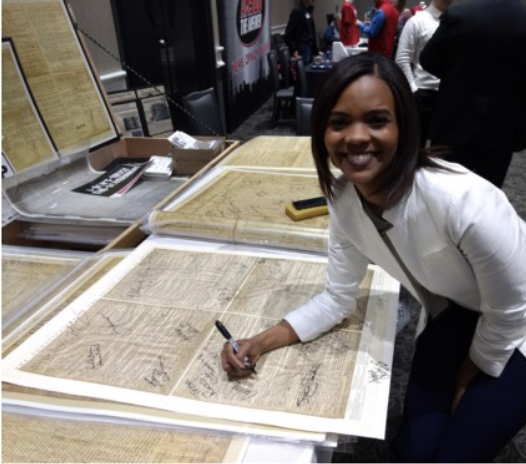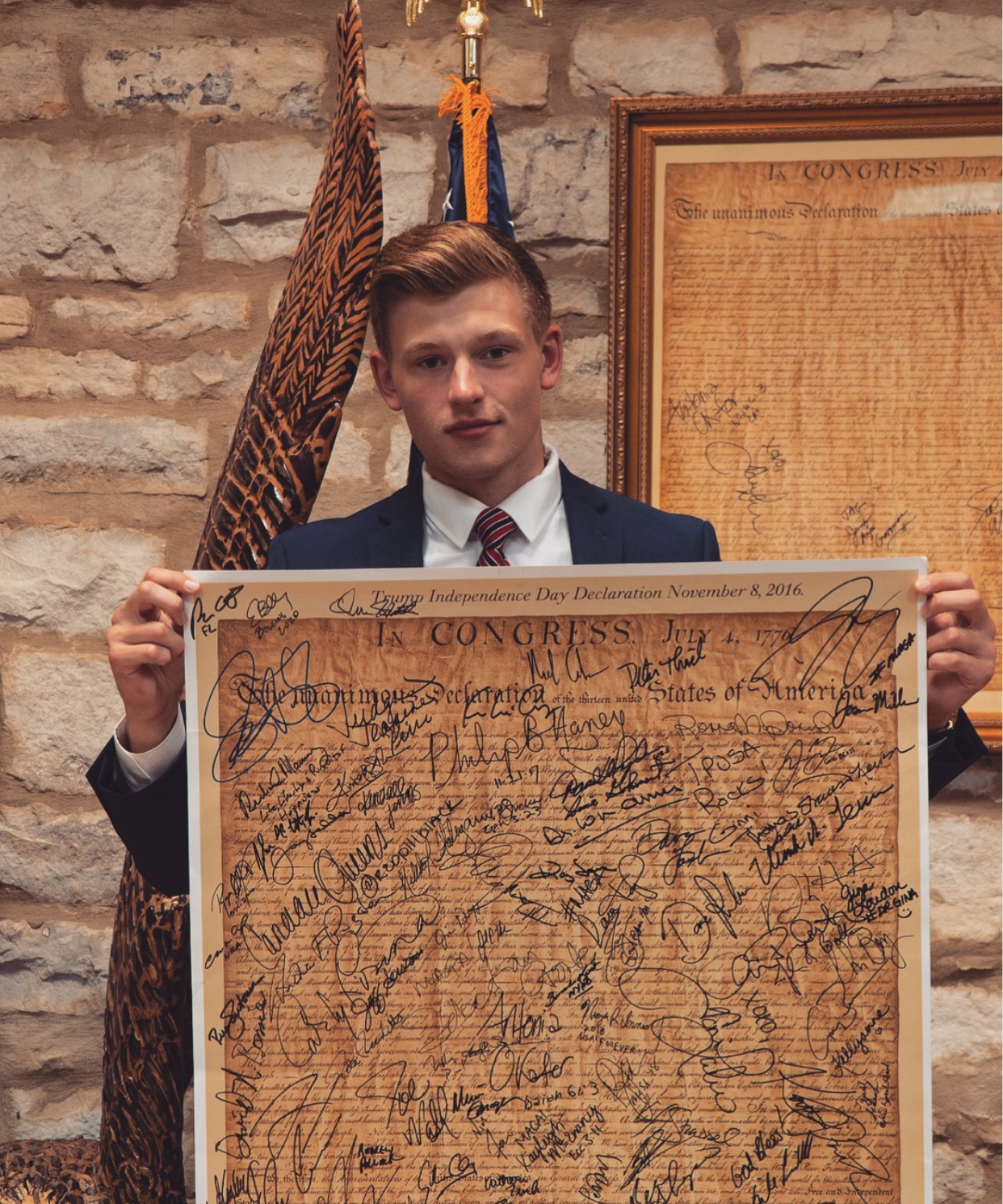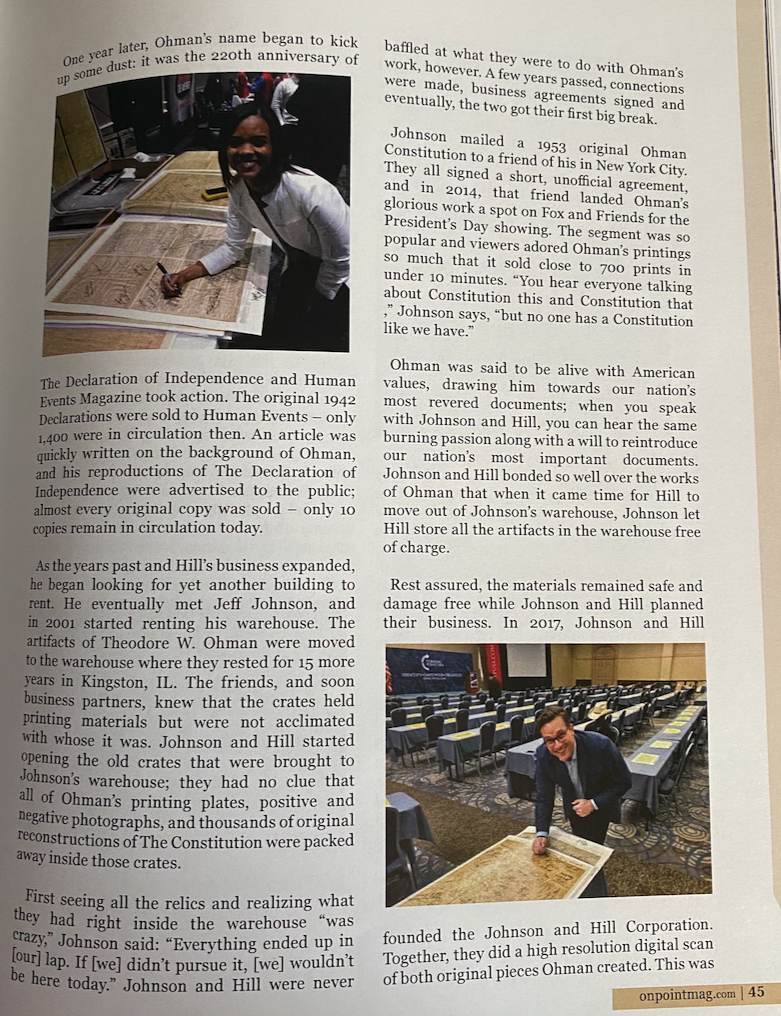Charlie Kirk, Founder & CEO of Turning Point USA
The founding documents of the United States of America, the Declaration of Independence and the Constitution, highlighted a true turning point in American history. The elegance and structure that was put forth in creating these documents still rings along with the sound of the Liberty Bell in what we know as freedom. The sad, unforeseen truth is that these documents are far from their original condition. After 242 years of true American wear-and-tear, they are but fragile shells, colorless silhouettes of what they used to be. One man vowed to change that; two men vowed to continue it.
The first man was Theodore W. Ohman: a man who had a burning passion for the United States of America; a man with a burning passion for its values. Ohman grew up in Czechoslovakia during the early 1900s – a difficult time to learn about American ideals. His school teachers were discouraged from planting the seeds of democracy in their students’ heads. Nonetheless, Ohman found a way to read and study both the Declaration of Independence and the Constitution. The words of Thomas Jefferson, Benjamin Franklin and Samuel Adams sparked a revolution inside him: a revolt from his current life towards a land of promise, ambition and freedom. Ohman gradually took up his family’s art of lithography, printing from a stone or metal plate with a smooth surface, where his curiosity of the physical documents of the American Constitution and Declaration grew. His imagination saw the actual, original document as an art. The reprinted versions had given him a love for America; he could only wonder what seeing the true, natural document would bring him.
Ohman’s immigration story is like that of any other: a star-spangled gaze as he passed the Statue of Liberty; a determined mindset as he looks back on the Founding Fathers; a gleaming expression as he enters the Land of the Free. He had been waiting for this moment for years. As Ohman took his final steps, as he took his first look, as he first inspected these ethereal documents, that amazing gaze shattered. The cornerstone of America, the Declaration of Independence, was disintegrated, destroyed and permanently ruined. The writing on which the United States was formed is faded and crushed; the writing on which Ohman shaped his view of America is worn and creased somewhere between the American Dream and the poverty line. But from this visit developed a purpose: Ohamn vowed to one day reproduce a genuine, perfect restoration of the prized Declaration of Independence.
Candace Owens, Turning Point USA’s Former Director of Communication, Founder of BLEXIT
Restoring a document of this type, in lithography, took pure dedication and a true passion, which explains why only one other person attempted a feat this size until it was undertook by Ohman. He loved America so deeply that he wanted to bring the angelic features and the historic morality of the piece together for the first time in American history. The scope of this project spanned years and utterly disregarded time and cost. From precisely cutting plates and molds, printing and gathering materials, the cost was not only monetary but also physical. In 1823, President James Monroe called upon John Quincy Adams to arrange an engraved copy of the Declaration of Independence. Adams hired William I. Stone, the most profound engraver during that time, to transfer the document onto a copper plate to forever memorialize it. Stone produced a wet transfer to ensure a perfect guide for the recreation – the wet transfer directly moved ink from the document onto the sheet of copper. Upon removal, seemingly all the signatures and part of the script had peeled from the original and stuck to the copper plate. It was at this time that the document was permanently damaged. Stone continued the task and, on genuine parchment, printed 200 limited edition copies of the Declaration of Independence. These copies made their way to primary government branches and descendants of the Founding Fathers. The remakes by W. I. Stone were only to be lost in history, until Ohman found an odd reproduction of the Declaration at an antique shop in the 1930s – to his surprise, it was one of the original 200 copies. Ohman used the W. I. Stone copper engraved parchment copy and an emulsion negative photograph (taken in 1903) to seamlessly draft, reshape, and embody the original document in its fundamental form. Ohman reshaped, by hand, every letter and every word over the cracks in the parchment copy so that the signatures and script would look beautifully unimpaired; he recolored and reshaped the paper in his version from the emulsion negative photograph so that it may be a perfect, exact copy. Ohman put his life’s study of lithography into his life’s work of recreating America’s pinnacle turning point.
In 1942, Theodore W. Ohman’s first replicas of the Declaration of Independence were finally complete. He printed roughly 30,000 copies and then decided to break the mold so no one else in the world could make any more like his. He taped the pieces of the mold together as proof that he had been the man who made one of the finest restorations ever done. In 1953, Ohman did the entire process over again to recreate the Constitution of the United States of America, with the Bill of Rights added to the bottom. Again, being famed for the precision of the work, it is one of the greatest recreations of the historical document. From the time that Ohman finished his work to the time that he died in 1968, the activity of his documents were unfruitful; few, if any, reported the story. Ohman’s estate was purchased by his personal friend Bill Utley; he moved Ohman’s equipment from Memphis, TN to Genoa, IL where it collected dust for 27 years. Utley put the equipment in crates and stored it in the basement of his office building. In 1995, Mark Hill bought Utley’s building in search of a new office building for his business. With the building, Utley tempted Hill by offering the crates for sale. Hill gladly bought the Ohman print materials. One year later, Ohman’s name began to kick up some dust: it was the 220th anniversary of the Declaration of Independence and Human Events Magazine took action. The original 1942 Declarations were sold to Human Events – only 1,400 were in circulation then. An article was quickly wrote on the background of Ohman, and his reproductions of the Declaration of Independence were advertised to the public; almost every original copy was sold – only 10 copies remain in circulation today.
Bennie Johnson, Turning Point USA’s Chief Creative Officer & personality
As the years past and Hill’s business expanded, he began looking for yet another building to rent. He eventually met Jeff Johnson, and in 2001 started renting his warehouse. The artifacts of Theodore W. Ohman were moved to the warehouse where they rested for 15 more years in Kingston, IL. The friends, and soon business partners, knew that the crates held printing materials but were not acclimated with whose it was. Johnson and Hill started opening the old crates that were brought to Johnson’s warehouse; they had no clue that all of Ohman’s printing plates, positive and negative photographs, and thousands of original reconstructions of the Constitution were packed away inside those crates. First seeing all the relics and realizing what they had right inside the warehouse “was crazy,” Johnson said: “Everything ended up in [our] lap. If [we] didn’t pursue it, [we] wouldn’t be here today.” Johnson and Hill were never baffled at what they were to do with Ohman’s work, however. A few years passed, connections were made, business agreements signed and eventually, the two got their first big break.
Johnson mailed a 1953 original Ohman Constitution to a friend of his in New York City. They all signed a short, unofficial agreement, and in 2014, that friend landed Ohman’s glorious work a spot on Fox and Friends for the President’s Day showing. The segment was so popular and viewers adored Ohman’s printings so much that it sold close to 700 prints in under 10 minutes. “You hear everyone talking about Constitution this and Constitution that,” Johnson says, “but no one has a Constitution like we have.” Ohman was said to be alive with American values, drawing him towards our nation’s most revered documents; when you speak with Johnson and Hill, you can hear the same burning passion along with a will to reintroduce our nation’s most important documents.
Johnson and Hill bonded so well over the works of Ohman that when it came time for Hill to move out of Johnson’s warehouse, Johnson let Hill store all the artifacts in the warehouse free of charge. Rest assured, the materials remained safe and damage free while Johnson and Hill planned their business. In 2017, Johnson and Hill founded the Johnson and Hill Corporation. Together, they did a high resolution digital scan of both original pieces Ohman created. This was to ensure that Ohman’s work would live on as the most admirable and most exceptional facsimile of the sacred American documents. Due to the way Ohman had to print his renditions, it would be “impossible” to try again, Johnson said. The process used to print the limited edition creations took the work of a professional, and indeed that’s what Ohman was. Johnson and Hill cannot print the way Ohman did, thus creating the scans. Johnson and Hill wanted to make known to the public these magnificent works, and they had to start somewhere. They created a website, AmericanScriptures.com, where the high definition scans are available for purchase in a multitude of options. What’s more, Ohman wrote the story of his passion before he died under a penname; that story can now be found on American Scriptures. That website was the beginning of the long road ahead for Johnson and Hill.
David Bruining, former Senior Editor of Turning Point USA’s News Department
It was the summer before CPAC 2017 and Johnson was on a mission to TPUSA headquarters in Lemont, IL.: the task was to recruit William Montgomery, co-founder of TPUSA, and inform him of the opportunity that was right in front of him. In the mail box, he left a folded up, original 1953 Ohman Constitution print, a copy of the Human Events Magazine article, and his contact information. To Johnson’s surprise, nothing came of it. Set the stage forward several months to CPAC 2017 where Johnson personally met William Montgomery, as well as Charlie Kirk. Montgomery immediately loved the idea and thought so highly of Ohman’s work and Johnson and Hill’s dedication to it. Coincidently at CPAC 2017, Johnson made the Johnson and Hill work truly one-of-a-kind.
Johnson was walking around CPAC with the prints and displaying them for everyone he could. “The thing about the prints,” Johnson says, “is they’re very visual.” Everyone is drawn to them and wants to know either how to get one or more about it. A crazy idea popped into Johnson’s head when he ran into Ted Cruz, the senator from Texas: he asked Cruz to autograph the Ohman prints. Ever since that day, Johnson and Hill have been going to a host of political conferences, some including Turning Point USA’s Student Action Summits and High School Leadership Summits. There, they have accumulated over 100 signatures from notable people like Ben Shapiro, Donald Trump Jr., Sean Hannity and Candace Owens, only to name a few. Johnson and Hill have put in countless hours traveling and gathering the signatures. The signing itself takes almost no time at all: “you only [have] 10 seconds,” Johnson says. “When [the speakers] get off stage, they either come and greet you, or their security people are pushing them right past you.” Whether it takes 10 seconds or 10 minutes, Johnson and Hill’s work does not go unrecognized. “You have to understand, this is an absolutely impressive number of signatures with these types of people,” says William Montgomery. Johnson and Hill are the first of their kind in this market. No other historical document outlet has the quality of work and passion that both Johnson and Hill express.
The Declaration of Independence was the United State’s true turning point. The Constitution was, and is, the United State’s true rule of the land. Jeff Johnson and Mark Hill are dedicated to spreading the heart of America to its people. “If you can do one thing, right now, as a young person,” Hill says, “read these 2 documents.” Johnson and Hill are helping Turning Point USA bring the founding principles of the United States back into society. The founding colonies of America had a vision: a vision of freedom from a tyrannical government; a vision of prosperity for all its citizens. The Declaration solves the prior, and the Constitution solves the latter. The ideas laid out in these exquisite documents cannot be forgotten, and they will not be forgotten through the work of Johnson and Hill. The course of action they are taking is one of the most important campaigns in all of campaigns across the country right now. As the partners put it, “we need to do everything to stop [a radical government] in this country, and this is [our] way to help.”












